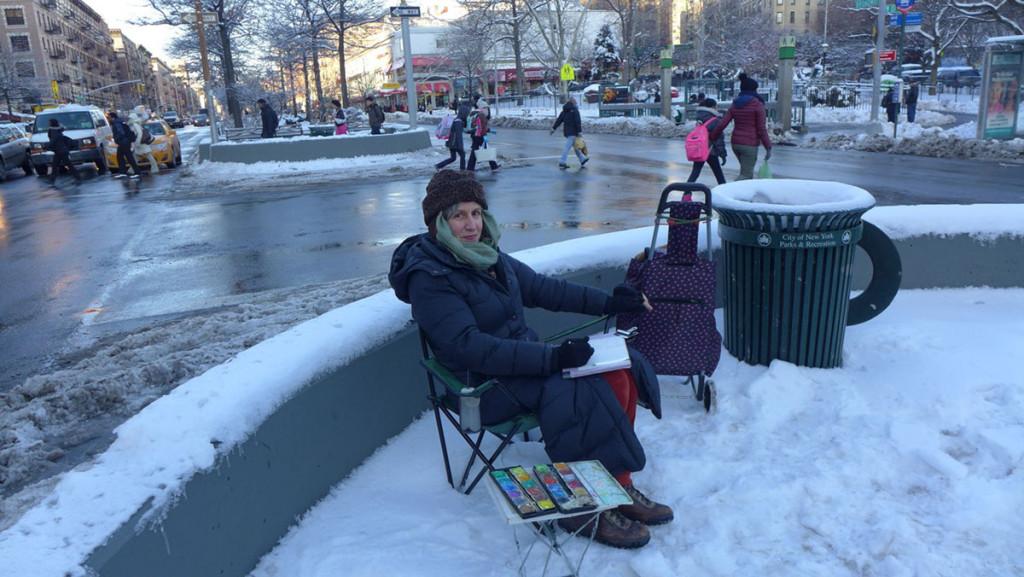On March 19, New York–based artist and painter Elise Engler will hold a reception from 5–7 p.m. at the Handwerker Gallery. Her works include “Taxing Times,” which depicts a list of objects Americans pay for in taxes, and “Collateral Damage,” which visualizes the military and civilian causalities from the Iraq war. From March 18 to April 17, Engler’s “Taxing Times” will be on display for the general public to view.
Engler teaches at the City University of New York and Battery Park City Parks Conservancy in New York City. Her works have toured in 13 states and seven countries.
Staff Writer Luke Harbur spoke to Engler about how her lifestyle related to her artwork, her teaching methods and what other works gallerygoers should expect to see in her exhibit.
Luke Harbur: What was one of the first pieces you created?
Elise Engler: I have a drawing that I did when I was 6 that is of rows and rows of little girls jumping rope. And in some ways it is related to my drawings now. You spend a lot of time going to art school and then you come back to your roots.
LH: You received a grant from the National Science Foundation Artist and Writer’s program in Antarctica to be an artist in residence. What was your experience like?
EE: For being an artist there, it is the same application as for being a scientist. I did a lot of research and a lot of reading. It took a long time for me to find out that I had actually gotten the grant. We had an orientation in Colorado, and they helped me put together a proposal that would make sense to go to the McMurdo base. I ended up in five different locations there, including McMurdo Station itself, which was a frontier town with about 1,200 people. I was also located by two penguin colonies.
LH: What influenced you to do something like this?
EE: I don’t think it’s my influence. I think it’s my nature. I hitchhiked from just south of Fairbanks, Alaska, to New York when I was 22 years old, so this isn’t my first big adventure by any means. I spent two months camping in Alaska in much more remote areas in some ways. I was also drawing there. That was a long time ago.
LH: What sorts of things are you currently teaching at City College?
EE: I teach them that the most important thing is to create a classroom and lessons that allow for the students to make their own choices.
LH: Do you believe that’s something being lost in classrooms today?
EE: Yeah. I think that teachers, especially in the K-12 system, are being turned into automatons. There’s too much standardization. Standardization is ridiculous.
LH: Is that one of the thoughts that influenced you to create “Taxing Times,” the piece coming to Ithaca College?
EE: “Taxing Times” is certainly reflecting upon what our priorities are. I worked on this from 2003 to 2008. I don’t like my work to be so explicitly didactic, because I don’t think that’s very interesting. I want the viewer to assemble his or her own thoughts.
LH: How would you describe your work, “Collateral Damage”?
EE: There are 30,000 small figures that represent casualties from Iraq. The initial drawing was of the Coalition casualties, so it was mainly American and British soldiers. But there were Italian, Spanish, Romanian and Polish soldiers, too. I think there were 19 countries that joined us in that invasion. I realized I left out the other side, so I started drawing the civilian casualties in Iraq.
LH: In October, you came to Ithaca College and had people redraw missing objects from the institution’s permanent collection from the ’70s. What type of work did you see people draw?
EE: They were given a specific card of the specific object. The objects ranged from a lot of ethnographic places. There were quite a few things from Nigeria and Peru, so there were clay pots and masks. There were prints from contemporary artists. I redrew all the redrawings, which is going into the college’s permanent collection. Each drawing is about an inch by a half an inch.
LH: What pieces are you currently working on?
EE: I’m working on a piece documenting Broadway, top to bottom. It’s 250 blocks of Broadway. It’s called, “The Year On Broadway.” I will end exactly one year from starting, May 18. It’s going to be one drawing, which will be approximately 6 inches high and 120 feet long. And there’s a photograph of me working on every single block.














